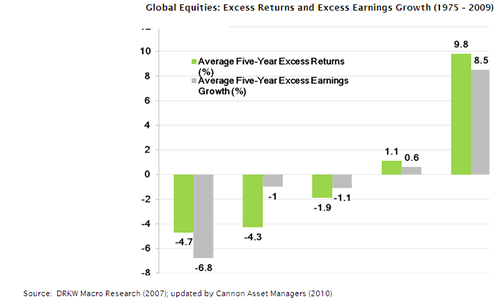Growth stocks which have high price-earnings (P/E) ratios don’t grow their earnings faster the market, according to a new research study by Cannon Asset Managers. The study was based on 10,000 global stocks over a 35 year period. The study analyzed two aspects of investment results namely the relationship between price-earnings ratios and investment returns; and the relationship between investment returns and earnings growth.
During the dot-com bubble times of the 1990s, investors bid up hi-tech stocks in the expectation that they will grow faster than the market. However that did not happen. Instead investors lost out big when the hi-tech bubble popped and tech stocks crashed wiping out billions in wealth.
The results of study contradict conventional wisdom on growth and value stocks. The two the main takeaways from this study:
- Growth stocks with high P/E ratios under-perform the market
- Growth stocks have earnings growth that are slower than the market but unloved value stocks deliver faster-than-market earnings growth
In the above chart, the left most Quintile 1 represents the basket of stocks with the highest P/E ratio while the right most Quintile 5 represents the stocks with the lowest P/E ratios. The green bar shows the average annual investment return, measured over five years, relative to the global equity market. Hence the expensive growth stocks in the Quintile 1 underperformed the market by an average of 4.7% per year. Similarly modestly expensive stocks underperformed by 4.3% per year. On the other hand, deep-value stocks in the Quintile 5 outperformed the market by an average of 9.8% per annum.
The grey bar measures the earnings growth relative to the market for each Quintile over five years. Value stocks have higher than the market average five year earnings than growth stocks.
Value shares outperform because of stronger-than-market earnings growth and growth shares under-perform because of poorer-than-market earnings growth.
This study conclusively proves that investors will be richly rewarded with value stocks as opposed to growth stocks. That does not mean investors ought to avoid all growth stocks. Some of them experience phenomenal growth and deliver awesome returns to investors. However such stocks are very few among the large pool of growth stocks and most investors fail to identify these winners.
Some examples of growth stocks are: Chinese internet search provider Baidu (BIDU) with a P/E of 97, online travel company Priceline (PCLN) with a P/E of 21, internet search giant Google (GOOG) with a P/E of about 20.




